ENTS,
Today I attended two programs at Cook Forest State Park, PA. The
first was program about amphibians and reptiles found in the
park. Dale Luthringer's blurb for the program was:
Saturday, May 27 at 1000am - 'Slide Show and Search for
Pennsylvania's Herps' What kinds of reptiles and amphibians are
found in Pennsylvania? Have you ever had a chance to see them up
close? Join Terry Laux, herpetologist for the Pennsylvania
herpetological Atlas Project, at the Log Cabin Inn Environmental
Learning Center for an intriguing slide show of PA's frogs,
toads, salamanders, snakes, skinks, and turtles. We will then
take our new found knowledge and strike out on foot to search
for and identify these amazing animals. (2 hrs)
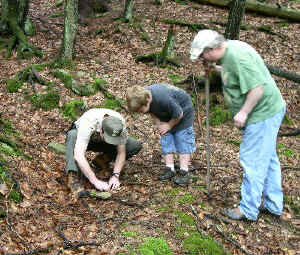
Terry Laux. son, and Dale Luthringer
Terry Laux gave a short slide presentation and then the group
headed down the Liggett Trail to search for salamanders and
frogs. I didn't expect to find very many as on a typical trip to
the park I will see few red efts and some frogs jumping into
pools as I approach but not much else. I don't tend to turn
rocks over and look under them for salamanders. Many, if not
most of them are more active at night, and the place to look for
them during the day is under damp woody debris and rocks near or
in hillside springs in the forest floor. There are a dozen
salamanders we reasonably might find in a search of the park. On
the hike there was a group of twelve people, including several
young boys, one of which was Terry Laux's son - an expert in
finding salamanders under rocks. We Found eight species (I may
be missing one of them):
Spring Salamander
Mountain Dusky Salamander
Northern Dusky Salamander
Red Eft (Red spotted newt)
Redback Salamander
Two-striped Salamander
Wherle's Salamander
Spotted Salamander
(see http://sites.state.pa.us/PA_Exec/Fish_Boat/salamander.htm
for some info and photos)
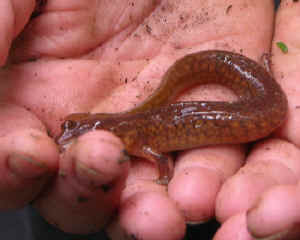
Spring Salamander Gyrinophilus porphyriticus
porphyriticus |
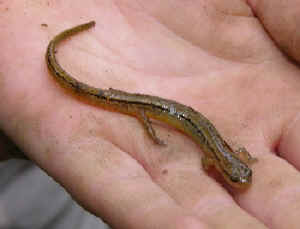
Two-lined Salamander Eurycea bislineata bislineata
|
This is a pretty good count for a single short walk along a
gravel road. We had found many dusky salamanders and a couple of
spring salamanders, when at the end of the journey one of the
boys found the spotted salamander. Several people had already
started to leave, and they were called to the find. It a a large
salamander, black in color with yellow spots. It is the largest
of the terrestrial salamanders found in the area and an uncommon
species to find. It the same pile of debris, near where Heffern
Run joins Tom's Run also yielded the first redback salamander,
and the first two-striped salamander of the day. This
marked the end of the formal field trip. A few of us continued
down another hundred yards or so to some vernal (maybe
perennial) pools off the side of the trail. They contained
hundreds of tadpoles swimming through the still water. On the
trip back we found a bird nest in a pocket in a road bank, and a
few more red efts. We saw or heard a couple species of frogs,
and a small toad to round out the amphibian foray.
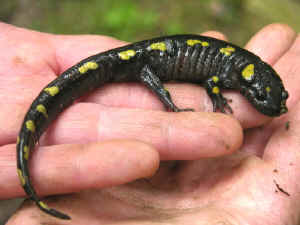
Spotted Salamander Ambystoma maculatum |
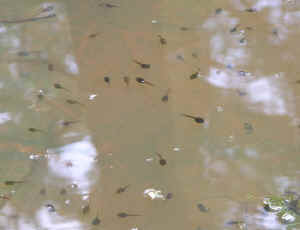
Tadpoles in vernal pool |
How does this relate to old growth forests? These salamanders
represent one of the many species that make up the complex
ecosystems of our forests. The area we were walking is not old
growth itself, but is contiguous to old growth in the park. In
areas with less disturbed environments the species diversity of
amphibians is generally higher than in area that have been
repeatedly cut again and again. The population numbers are also
higher. That is one characteristic of a healthier ecosystem.
The second program of the day was a trip through the Forest
Cathedral area conducted by Dale Luthringer:
Saturday, May 27 at 200pm - 'A Walk Through the Forest
Cathedral' Please meet at the Log
Cabin Inn Environmental Learning Center for an interpretive hike
into the Forest Cathedral. Observe the 5th tallest tree in the
entire Eastern U.S., learn how to identify old growth forest
characteristics, and observe different types of environmental
disturbance that are an integral part of old growth forest
ecosystems. (2 hrs)
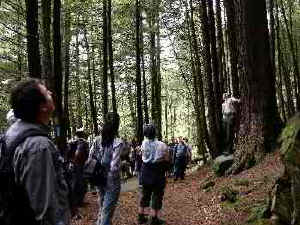
Along the Longfellow Trail
Anthony Kelly - another ENT - also attended this program. The
hike began at the Log Cabin Inn where Dale pointed out the
difference between Eastern White Pine and Eastern Hemlock. He
pointed out the 80+ year old hemlocks less than 3 inches in
diameter. We visited the Seneca Pine, the Longfellow Pine, and
many trees in between and Dale gave his usual exemplary
discussion of Old Growth, Cook Forest, and related topics. We
looked at more salamanders, woodpecker holes, downed trees, moss
and lichens, listened for birds, and most of all Dale talked
about what we were seeing in the forest, the trees, and the
process that were taking place as the forest grows, ages, and is
reborn.
|